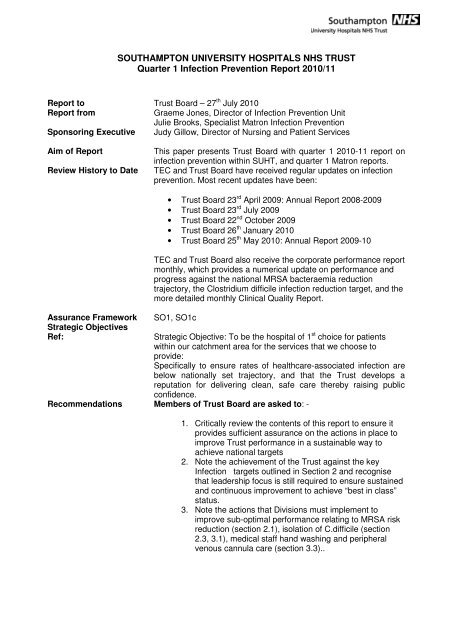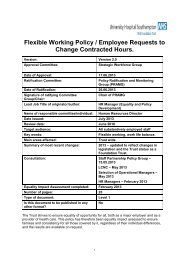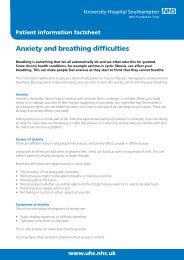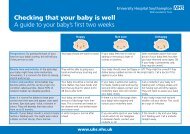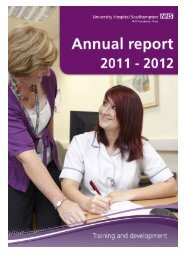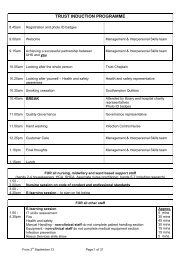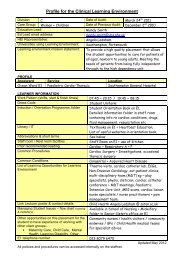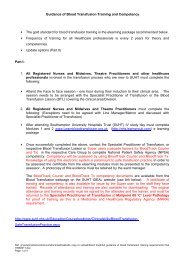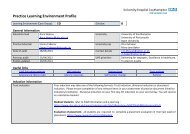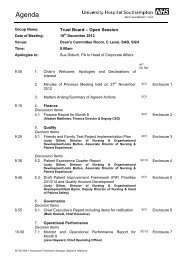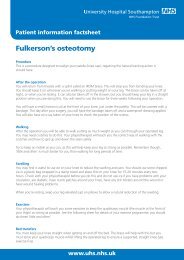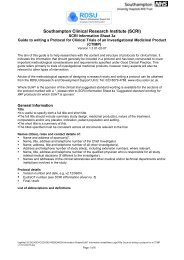Enc L - University Hospital Southampton NHS Foundation Trust
Enc L - University Hospital Southampton NHS Foundation Trust
Enc L - University Hospital Southampton NHS Foundation Trust
You also want an ePaper? Increase the reach of your titles
YUMPU automatically turns print PDFs into web optimized ePapers that Google loves.
1. IntroductionThe attached paper provides a summary report on work to reduce MRSA and Clostridium difficilewithin the <strong>Trust</strong> for Q1 in 2010-11, and also includes quarter 1 Matron reports.1.1 Summary of progress – Quarter 1 2010/11Category RAG Action /CommentTargets:Provideassuranceof basicinfectionpreventionpractice:MRSA BacteraemiareductionMRSA screeningClostridium difficileinfection reductionReduction of other post48 hour bacteraemiase.g. MSSA.Reduction of sourcerelated infections e.g.Surgical Site Infection,ventilated associatedpneumonia, invasivedevice infections.CQC assuranceframeworkHand hygiene andSaving Lives high impactinterventionsPrudent antibioticprescribing1 post 48 hr MRSA bacteraemia in Q1.Annual target for 2010/11 is no more than 7post 48 hr MRSA bacteraemias.99% of all elective and 99% of allemergency cases screened at patient levelreporting. Matched census reporting>100%.35 cases in Q1. National target for 2010/11is no more than 139 cases with a stretchtarget of no more than 110 cases for theyear.8 Post 48 hr MSSA BSI in Q1.98% compliance with SSI saving livesaudit.100% compliance with VAP saving livesaudits.Amber areas relate to cleanliness and theenvironment, failure to complete isolationrisk assessments and out of date policies.Improved action plans in place.Q1 clinical hand hygiene audit at %compliant. Medical hand hygiene audit forQ1 has not met the target of 95%compliance.NB: MSSA – Methicillin Sensitive Staphylococcus aureus as opposed to Methicillin ResistantStaphylococcus aureus.2
2.2 MRSA ScreeningTargets:1. All emergency admissions and each relevantindividual elective admission has been screenedfor MRSA .10090SUHT MRSA ScreeningProgress:SUHT is achieving 99% screening success atindividual patient level, for both emergency andrelevant elective cases,Matched census data is > 400% and is accepted bySHA for assessment of achieving 100% target.Prevalence of MRSA colonisation is 0.5% for electivepatients and 1.5% for emergency patientsSummary of actions:Internal targets for MRSA screening efficiency are tobe reset at:Elective target of 95%Emergency target 98%The current system of RCA’s will be completed for nonscreens once below target.These targets were agreed at TEC in December 2009and have been confirmed with SHA as appropriate.Screening Efficiency (%)80706050403020100Oct-08Nov-08Dec-08Jan-09Feb-09Mar-09Apr-09May-09Jun-09Jul-09Aug-09Sep-09Oct-09Nov-09Dec-09Jan-10Feb-10Mar-10Elective Apr-10 May-10 Jun-10Division 1 99.8% 100.0% 99.8%Division 2 100.0% 99.4% 99.4%Division 3 96.2% 100.0% 99.4%Division 4 99.6% 99.4% 99.8%Division 5 100.0% 100.0% 100.0%Day CasesDivision 1 97.9% 98.0% 99.6%Division 2 99.7% 98.3% 99.1%Division 3 98.7% 100.0% 100.0%Division 4 97.9% 100.0% 99.2%Division 5 100.0% 100.0% 100.0%ElectiveDay caseEmergencyEmergency
2.4 Other Post 48 hour BacteraemiasSUHT Post-48h MSSA bacteraemiaStaphylococcus aureus is a bacterium that commonlycolonises skin but may become a cause of seriousinfection in some individuals. S. aureus bacteraemiacaused by organisms resistant to the antibioticmethicillin (MRSA) are formally reported andperformance managed by DH. Most S. aureusbacteraemias are caused by organisms that aresensitive to the antibiotic methicillin – termed MSSA.Reporting of MSSA bacteraemia is now mandatory,although not formally monitored at national level.No of Cases109876543210Post - 48h MSSA bacteraemia SUHT 2010-2011Apr-10 May-10 Jun-10 Jul-10 Aug-10 Sep-10 Oct-10 Nov-10 Dec-10 Jan-11 Feb-11 Mar-11Post 48 HourProgress8 post-48h MSSA bacteraemias occurred in Q1.RCA of post-48h MSSA bacteraemias has beenperformed since June 2010 and the first CEO reviewtakes place in July to establish points forimprovement.Source of n CaregroupMSSAbacteraemiaCVC 3 Obs & Gyne (2)CancercarePVC 3 Cardiothoracic (2)Child heathSurgical site 1 T&OinfectionOther 1 MOP/T&OAll cases from Obstetrics & Gynaecology originatedfrom the Neonatal Unit.6
2.4 Other Post 48 hour Bacteraemias (cont…)SUHT post-48h E coli bacteraemiaReporting of E. coli bacteraemia is currently voluntary,but HPA have recommended mandatory reporting toDH. Most E. coli infections arise from patients ownbowel flora and 100% of the population are colonisedby E. coli.DH have announced provisional plans to require<strong>Trust</strong>s to reduce hospital-acquired UTI by 50%, but nodetails are available yet. 12 post-48h E colibacteraemias occurred in Q1 of which 7 (58%) wereassociated with urinary infection.No of Cases109876543210Post - 48h Ecoli bacteraemia SUHT 2010-2011Apr-10 May-10 Jun-10 Jul-10 Aug-10 Sep-10 Oct-10 Nov-10 Dec-10 Jan-11 Feb-11 Mar-11Post 48HrSummary of Actions:Introduction of RCA of selected post-48h E colibacteraemias has been deferred pending detail of DHrequirements. Preparatory work being undertakenincludes a scoping exercise to determine urinarycatheter use and development of practice guidelinesfor care of catheters.Source of E. coli n CaregroupbacteraemiaUrinary tract 7 O&GCancercareSurgeryMedicine (3)NeurosciencesGastrointestinaltract4 CardiothoracicO&GChild HealthSurgeryHepatobiliary 0systemCVC 0Respiratory tract 1 CardiothoracicUnknown 07
2.5 Source Related InfectionsSurgical Site InfectionsCurrently there are 14 HPA surgical site infectionmodules which provide opportunity to benchmarkoutcomes against other participating units. All <strong>NHS</strong>trusts performing orthopaedic procedures are requiredto undertake a minimum of 3 months surveillance peryear in at least one of the four orthopaedic categories.Other modules are currently optional.Divisions which undertake elective surgicalprocedures are developing plans for enhancingsurgical site surveillance by participating in nationalsurveillance modules..Division Care group SurveillancecategoriesCurrentlyundertaken1 Surgery Bile duct liver Npancreatic surgery NGastric surgery NLarge bowel surgery NSmall bowel surgery NT&O Hip replacement YKnee replacement YLong bone fracture NRepair of neck of femur YSpinal surgery Underdiscussion3 Gynaecology Abdominal Nhysterectomy4 Cardiothoracic Coronary bypass graft NLimb amputation NVascular surgery NNeurosciences Spinal surgeryTo beimplemented2010Recentlyundertaken07,08SSI Saving Lives AuditQ1 audit results show 95% compliance againstpreoperative and 100% compliance againstperioperative standards of care.Q1 results have shown a 4% reduction againstpreoperative standards compared to Q4 result of 99%.Infection Prevention Team are providing support andeducation to areas of poor compliance.SSI Audit May 2010;% compliance1009080706050403020100SUHT Preventing Surgical Site Infection (Preoperative May2010)85% ObservationsAchieved99MRSA Screening95 95MRSADecontaminationAll Elements?SUHT Preventing Surgical Site Infection (Perioperative May2010)% compliance100908070605040302010078%ObservationsAchieved100 100 100 100 100Hair RemovalProphylactic NormothermiaAntimicrobialGlucoseControlAll Elements?8
2.6 Source Related Infections (cont….)Ventilated Associated PneumoniaVAP Audit Results in April 2010;Currently there is no national standard for measuringrates of Ventilator Associated Pneumonia. SUHTprovides audit compliance data to commissioners.10090SUHT Audit of Care of Ventilated Patients (Observation April 2010)100 100 100 100 100 100 100Q1 audit results showed 100% compliance againststandards of regular observation and 100% againststandards of ongoing care.8070605040803020100% ofElevation ofSedationDeep VeinGastric UlcerAppropriateTubingAll ElementsObservations the head of theholdingThrombosisprophylaxishumidification managementAchievedbed to 30-45prophylaxisof inspired gasdegreesSUHT Audit of Care of Ventilated Patients (Ongoing Care April 2010)100100 100 10090Invasive Device Infections807670Saving lives audit for Central Venous Catheter is notdue until 31st July 2010.60504030During 2010/11 critical care units will undertake RCA’sfor CVC related bacteraemias as a component ofparticipation in the Matching Michigan nationalprogramme, to ensure learning is identified and actiontaken to achieve further focused reductions inbloodstream infections.The Matching Michigan project is based on a modeldeveloped in the USA that took place in ICU’s inMichigan. The project introduced measures to reducecentral venous catheter associated bloodstreaminfections and achieved a reduction in infection to 1.4infections /1000 CVC days. The aim is for participatingUK units to match this rate20100Observations AchievedSuctioning of respiratorysecretionsOral hygieneAll Elements9
2.7 Norovirus and Other OutbreaksDuring Q1 there have been 3 D&V outbreaks of which2 were confirmed as norovirus.Graph shows number of all infectious outbreaks in the<strong>Trust</strong> and bed days lost.Actions resulting from review of experience ofnorovirus infection this winter include:• review <strong>Trust</strong> outbreak framework andescalation plan• Further staff education and support arounddecision making• Review of D&V Policy and action card• Wards to develop mechanisms to ensureinformation is available in a timely manner• High-level discussion re: the timing and priorityof terminal cleaning in relation to the impact onquality of care at ward level and impact onservice delivery.SUHT Outbreaks & Alerts From April 2010250200150100500Apr-10May-10Jun-10Apr-10 May-10 Jun-10No of Bed Days Lost 33 0 49No of Patients Affected 19 7 11No of Staff Affected 13 0 0No of Deaths Attributed to Outbreak 0 0 0No of Outbreaks 3 2 19876543210No of Out BreaksThese are being incorporated into a new infectivediarrhoea policy.Other Outbreaks in Q1:Parainfluenza outbreak in Division 2.10
3. Assurance of Basic Infection Prevention Practice3.1 CQC Assurance FrameworkTarget:Compliance with all 10 criterions of the Hygiene Code 2008, CQC outcome 8.Progress:SUHT is currently partially compliant against Criterion 2 – cleanliness and the environment and Criterion 7& 9, which relates to isolation; failure to adhere to <strong>Trust</strong> policy through completion of isolation riskassessments and out of date policies.Reporting process has been amended, exceptions are now reported to the Quality Governance SteeringGroup and Infection Prevention Committee.Criterion 2 – Cleanliness and the EnvironmentCleanliness issues have been highlighted through the Infection Prevention Team spotlights, environmentalaudits, Environmental Monitoring Cleanliness Audits.Actions undertaken:• Infection Prevention Ward Accreditation scheme has gone ‘live’. All areas are to comply with auditstandards and achieve full accreditation by 30 th September 2010.• Cleanliness and decontamination focus week 28 th June -16 th July. Implementation of saving lives highimpact care bundle to improve cleaning and decontamination of equipment and increase assurancearound clinical cleaning responsibilities and standards.• IPT providing support and follow up to areas of non compliance with environmental audits.Further actions required to achieve green:• Enhancement of cleanliness standards by implementation of joint routine monitoring between IPT,Environmental Monitoring Team (EMT), Medirest and Matrons.• Continued monitoring through IPT spotlights, EMT cleanliness audits, Matrons walkabouts.• Medirest ongoing monitoring and assurance at weekly meetings.• Discussions to take place around defining what is acceptable level of dust.• Environmental Operational Steering Group to focus on hot spot areas re environmental cleanliness,identify themes and further actions – Aug 2010.• IPT to implement monthly walkaboutsCriterion 7 – IsolationIssues are ongoing around the failure to complete isolation risk assessments for infectious patients. SinceJan 2010, there has been a gradual increase in failures to isolate C.difficile patients.Actions undertaken:• <strong>Trust</strong> Isolation policy has been updated and is available on the SUHTranet.• Memo sent out to all regarding the requirements of isolating patients.• Monthly information sent to Divisions with regards to C.diff patients that did not have isolation riskassessment completed, for feedback to clinical area.• Weekly discussions at delivery group around failure to isolate C.difficile patients.Further actions required to achieve green:• C.difficile policy updated and awaiting validation.• Engage Matrons in spotchecks for isolation.• Discussions to take place around isolation capacity at Infection Prevention Committee in July, gainassurance around new Divisions and plans for cohorting.• D&V policy to be updated, and awareness week planned for September 2010.• Clinical areas to focus on issues picked up through failures to isolate.Criterion 9 – PoliciesAll out of date policies are currently under review. Failure to adhere to Isolation policy relates to actionsunder Criterion 7.11
3.2 Infection Prevention Accreditation ProgrammeTarget:Implementation of Infection Prevention AccreditationScheme by April 2010.All areas to be fully accredited by 30 th September2010Progress:Accreditation status for each clinical area in the <strong>Trust</strong>has been calculated based on the Saving Lives,hand hygiene and environmental audits completedApril 09 – Dec 09. 88 clinical areas have achievedfull accreditation (Green) with an overall score of95% or more. There are 28 amber areas, whichhave achieved partial accreditation and will bereviewed following the next round of audits (Sep2010). Two red areas remain unaccredited.Summary of actions:Divisions have action plans to achieve fullaccreditation in all areas by the next cycle of auditsin September 2010. Areas that achieve 95% will beawarded full accreditation.The table below shows the overall score by Divisionbased on the audits completed April 09 – Dec 09.This is calculated by obtaining an average score fromthe ward/departmental scores. The table also showsthe % number of audits that were completed for thisperiod.DivisionTHQ: Wellcome<strong>Trust</strong>OverallStatusOverallDivisionalScore% numberof auditsachieved1 96.8 82.32 96.8 73.83 94.0 84.64 98.3 85.45 96.699.3 100The % number of audits completed for Division 5 hasnot been calculated due to confusion during the auditschedule which has now been resolved.Fully accredited and partially accredited areas havebeen issued a certificate for public display at the<strong>Trust</strong> ‘Celebrating Success’ event in July 2010.12
3.3 Hand Hygiene and Saving LivesTarget:Clinical areas are required to achieve 95%and above compliance against handhygiene and saving lives audits.Progress:Q1 clinical compliance to hand hygiene -results not yet analysed. March resultsshowed improvement on Jan audit.Q1 medical compliance to hand hygienestandards has dropped from 94% inFebruary 2010 to 91% in May. Division 1have shown a significant reduction incompliance and actions are now in place atward level to improve compliance.For Q1, peripheral line audit has shown adecrease in compliance. SUHT overallaudit score in February 2010 was 98%compared to the reduced score of 95% inJune. Independent audits of practice areimminent to reinforce compliance.For Q1 renal dialysis audit, Division 3showed 100% compliance, compared to50% in January audit.Areas that score below 95% are required toimplement actions and re-audit as per theinfection prevention audit programme.Summary of actionsDuring 2010/11 IPT are implementing a<strong>Trust</strong>-wide rolling programme of infectionprevention focus weeks to educate staff andraise staff awareness of key practiceelements/initiatives and facilitateachievement and maintenance of highstandards of infection prevention practice.The first organised week in April 2010focused on hand hygiene.Hand Hygiene Audit:Clinical hand hygiene audit results% compliance:DivisionMar2010SUHT 971 992 993 964 965 94Currently awaiting all submissions for June audit.Medical hand hygiene audit results% compliance:Division May 2010SUHT 911 712 933 984 995 100Peripheral Line Care Audits:% compliance:Division June 2010SUHT 951 922 963 944 955 91Urinary Catheter Care Audits:Audit not due until August 2010.Renal Dialysis Audits:% compliance:Division April 2010SUHT 1002 No patients3 100
3.4 Prudent Antibiotic PrescribingAntibiotic consumption data from the SUHT pharmacysystem demonstrate a slow increase in use ofantibiotics considered high risk for C difficile andMRSA and reduction in use of low risk agentscompared to the position 12 months ago.. The trendtowards an increase in prescribing of very broadspectrum antibiotics and antifungal drugs during 2008and 2009 has plateaued.at around 12% and reflectsnational trends. Several caregroups includingCardiothoracic, Child Health and Neurosciences showan increase in antibiotic usage per admission and alsoincreased use of broad-spectrum agents. Ongoingusage is under review and will be subject to additionalscrutiny if variation continues.70%60%50%40%30%20%10%0%<strong>Trust</strong>wide Antimicrobial Use By Risk Classification(12 Month Rolling Average)Oct-06Nov-06Dec-06Jan-07Feb-07Mar-07Apr-07May-07Jun-07Jul-07Aug-07Sep-07Oct-07Nov-07Dec-07Jan-08Feb-08Mar-08Apr-08May-08Jun-08Jul-08Aug-08Sep-08Oct-08Nov-08Dec-08Jan-09Feb-09Mar-09Apr-09May-09Jun-09Jul-09Aug-09Sep-09Oct-09Nov-09Dec-09Jan-10Feb-10Mar-10Apr-10May-10Antifungal Antiviral High risk Intermediate riskLow risk Specialist Ultra broad spectrumAn online electronic learning module for antimicrobialprescribing is also in development with SUHTLearning Media and will be available for all <strong>Trust</strong>doctors and pharmacists in 2010.14
4 MiscellaneousMatrons Report – Summary of Key themes:Matron’s reports continue to demonstrate a strong culture of ownership and engagement with the InfectionPrevention agenda. The common themes identified include:• Maintaining performance in relation to MRSA• Ongoing focus on compliance with MRSA screening and the MRSA policy• Ongoing focus on compliance with clinical practice standards relating to infection prevention e.g. handhygiene, saving lives care bundles, and recognition of this via the ward accreditation scheme.The reports also highlight the following challenges:• Management and decision making relating to patients with diarrhoea• Focus and improvement in relation to other HCAI blood stream infections.• Achieving all quality aspects of medirest contracts for cleaning and catering e.g. consistently achievingNational cleaning standards all of the time.• Challenges with estates and facilities issues that impact on infection prevention and control.The full reports are included in Appendix A.Financial Information:The Dept of Health estimates that each MRSA bacteraemia costs approximately £10,000.Cost percase MRSAbacteraemiaNumber ofcases 2005-2006 inSUHTTotalestimatedcost toSUHT2005-2006Actualnumber ofcases 2009-2010Totalestimatedcost toSUHT2009-2010Costreductionachieved£10K 92 £920K 7 £70K £850KThe cost per case of C.difficile was estimated to be £4K; based upon detailed economic evaluation publishedin 1996 (Wilcox 1996). This will now be a conservative estimate due to the impact of inflation.Cost percaseClostridiumdifficilediarrhoeaNumber ofcases 2005-2006 inSUHTTotalestimatedcost toSUHT2005-2006Actualnumber ofcases 2009-2010Totalestimatedcost toSUHT2009-2010Costreductionachieved4 000 699 £2.8 million 143 £572k £2.2 millionThe <strong>Trust</strong> has invested heavily in infection prevention via the core Infection Prevention Team and via clinicalservices, and the cost-reductions achieved through reduced infection rates demonstrate this investment to becost-effective.Risk Register Ref:Risk number: 27 (corporate risk).Legal Implications:Continuing to exceed the MRSA bacteraemia target could be viewed by the Healthcare Commission as abreach of the Hygiene Code, and result in an improvement notice.The <strong>Trust</strong> continues to take focussed action to reduce this risk, in collaboration with the Department of Health,the SHA and local PCTs, including implementation of a high-level MRSA Recovery Plan endorsed by all.Carbon Management: Not specifically relevant15
Appendix A: Matron Reports:Division 2 Matron and CGCL Report to TEC/<strong>Trust</strong> BoardDivision: Unscheduled Care DivisionSpecialist MedicineCancer CareDivisional Management Team:DCD Dr Derek SandemanDDO Francis WisemanDHN/P Caroline Ainslee ( w/c 5.7.10)Care Groups: Emergency MedicinePerformance Update: 1 st April 2010 –30 June 2010Key Indicator Number Target StatusMRSA0 2 GreenBacteraemiaClostridiumdifficile diarrhoea13 16 GreenHCAI-RelatedDeathsOutbreaks ofInfectionNumber Cause Comments1 MRSA urinary Sepsis3 2 confirmed paraflu in cancercare1x Norovirus medicine2 cases of increasedincidence of C-diffIssues of cleaningstandards andsteamplicity werehighlighted.Key Learning from Investigation of Infections and Deaths:Key themes in all cases are:-Documentation of MRSA screening improved and consistently at over 99%.Overall practice consistently good with occasional individual errors occurring, which areaddressedOngoing challenges with delivery steamplicity and impact upon cleaning. Working in partnershipto address issues when they arise.From RCA analysis of MRSA screening equest access has been included on all inductions andpractice has improved MRSA screening to 100%Slight changes made in nurse allocation during paraflu outbreaks. High temperature in theclinical areas led to patients doors being opened which may have affected spread. Reflectiveglass now in place to keep rooms cooler and ensure that doors can be closed.Progress and Success:- MRSA bacteraemia remains a significant achievement for the case mix that present to thedivision.- C.difficile infections have risen but currently undertarget. Ribotyping confirmed high incidenceof different strains therefore not an outbreak.- Key learning from other RCAs of pressure ulcers and incidents has highlighted documentationof assessment from community admissions as significant when identifying the areas of focus(community and SUHT).16
Ongoing Challenges:- Capacity challenges due to patient demand and acuity- D5 Staffing 40% of current workforce are temporary until recruitment is complete (eitheragency or borrowed from other ward areas).- Steamplicity implementation: improvements have been made and now work on sustainabilityof service underway.- Pressure remains on the Emergency Department (ED) in estate as cleaning with high volumeuse an issue (resuscitation bay and majors).Summary of Action since Last Report, Current Focus and Action Plan:- Pending MEP bid outcome regarding equipment in ED--Ongoing actions regarding cleaning with medirest and Steamplicity- Weekly operationalmeetings for D and G level with Matrons.Ongoing actions regarding any individual practice issuesWork around supporting junior nurses to challenge isolation decisions in support of newguidance and checklist being piloted.Any Other Issues To Bring To The Attention of TMB and <strong>Trust</strong> Board:Issues of that have been challenging for the Division:Capacity constraints have remained challenging until June 2010.This resulted in a largeincrease in bed moves, which impact upon the patient safety and experience.Legionella has been found in 6 shower cubicles on C6. This currently has no impact on beds as9 beds in the unit are uncommissioned. 8 more rooms currently being checked. Fullinvestigation being led by Infection Control( Dr Yam) and supported by Estates. No risk topatients .However financial impact related to cost of replacement pipe work and filter systems.Date report produced: 30 June 2010Author: C.Rogers17
Division 3 Matron and CGCL Report to TEC/<strong>Trust</strong> BoardDivision: W&C Care Group: O&G and Child HealthMidwifery matron: Julia ClarkMatron for Neonates: Carol WoolridgeChild Health Matrons: Cath Battirck and Carol PurcellCare Group Clinical Lead: Gunter ReinhardtPeter Wilson/Rob WheelerPerformance Update: 28 th May 2010 – (end of previous month)Key Indicator Number Target StatusMRSA0 0 GreenBacteraemiaClostridiumdifficilediarrhoea0 2 (midwifery) GreenHCAI-RelatedDeathsOutbreaks ofInfectionNumber Cause Comments00Key Learning from Investigation of Infections and Deaths:1 NeonatesAs a result of recent Pseudomonas outbreaks and root cause analysis, theNeonatal Unit regularly audits patient movements on the unit and also theintensive care equipment in use on all babies.All staff are aware that the sinks on the neonatal unit are a source of pseudomonas andscrupulous hygiene is therefore maintained.Likewise all staff on the transitional care unit are aware that the sinks could be apotential source of pseudomonas.The 6-month trial of rapid testing for MRSA has now completed. All babies arescreened for MRSA on admission and on a weekly basis. The unit has recently caredfor babies with CMV infections. One of the babies was nursed in isolation for severalweeks.Progress and Success:2 MidwiferyBafta award for ‘one born every minute’ programme!Retention of staff has been more successful this year; although this has anunfortunate effect on the 24 student midwives due to qualify in the Autumn, asthere are currently only 12 wte vacancies for them.18
A very successful preceptorship programme is in place – with newly qualifiedmidwives acquiring suturing and cannulation skills in a supportive environment.We successfully achieved the appraisal rates required for the last quarter.Heat wave plans are in place.Sally Wood continues as link midwife for infection prevention has initiated andmaintained display boards re MRSA screening and Saving Lives audits, andhas been a real helpful presence in encouraging and educating staff re thehygiene code. Her team has increased with link midwives now in each area andalso on Night duty and in the High Dependency Unit. She has a rollingprogramme of mask fit testing in place.Regular walk rounds with Anne Schreiber, infection prevention link continue,proving to be useful and helping to encourage staff. A programme is now beingdeveloped to encourage all Band 7 midwives to engage with these walk-rounds.3 Estates major projects in handBurley and Broadlands sluice, treatment rooms, shower rooms and kitchens stillawaiting refurbishment. Negotiations continue to commence with refurbishingBroadlands shower rooms as a priority as women give birth on this ward andthen have to bath in outmoded bathrooms. A meeting is arranged with estateson 16 th June to discuss further but it seems as if Gynae will get initialrefurbishment with maternity awaiting 2011/12 to be completed.Clinical standards for cleaning of equipment have been maintained andevidence is up-to-date and available.4 NeonatesThe new Suction Policy has now been completed and can be found on theSuhtranet. This policy was written by the neonatal physiotherapist as a directresult of the pseudomonas outbreak.All nursing and medical staff are totally engaged in hygiene processes.Two dedicated domestic staff are employed are fully committed to themaintenance of the highest standards of cleanliness.A dedicated domestic is employed on the transitional care unit.5 Child HealthActive training and communication of infection control within care groupcontinues.Link nurses given dedicated timeLight box purchased and ongoing awareness training re hand hygiene for allstaff groups19
6 Ongoing Challenges:78 MidwiferyA bid of £27,000 is to be discussed by divisional board. This money will be usedto bring the maternity unit up to Care Quality commission standards byreplacing inappropriate soft furnishings and removing carpets in clinical areas.Maternity comes under increasing scrutiny from public bodies and the users ofthe service and it is vital to have an environment that meets infection preventionstandards and promotes a good standard of care to the public.Managers and Sandra Hoskyns, head of security, have undertaken a fullsecurity report. The site has problems due to the multiple entrances availablefrom the car parks, these are now locked overnight and further measures toimprove existing security are being investigated.Providing 1:1 care in labour remains a challenge particularly during peaks inactivity combined with midwifery staffing issues re sickness, maternity leaveand vacancies and uses up most of our resources. A new contingency plan formanaging workload and capacity problems is in the final consultation stage andwill be disseminated on 21 st June. Also a template from the NPSA is beingintroduced to audit basic staffing standards.All staff currently engaged with maintaining hygiene code standards.The charges for minor works seem exorbitantly high and this has an impact onboth the budget and the upkeep of the area.All linen stored appropriately but the trolleys are still not up to <strong>Trust</strong>requirements.9 NeonatesPseudomonas is known to be present in the sinks on the neonatal unit and it istherefore vital that staff remain aware and vigilant of all hygiene processes at alltimes.10 Child HealthLack of isolation facilities in some ward areas, especially during RSV seasonOct – FebPHDU Challenges - on-going problems associated with no isolation rooms. 2 ofthe 4 PHDU beds have been closed for over a week due to 2 children needing!:1 nursing to avoid cross infectionLack of ensuite facilities with cubicles provides poor dignity for older childrenand young people20
Maintaining adequate staff numbers on all shifts.Increasing numbers of children admitted to child health for tertiary servicesfrom other children’s units who are already colonised with MRSA.Difficulty in repatriating children back to referring units, some of whom haveMRSA, new charity ambulance in PICU helpingStructural layout and lack of storage facilities hampers the ability to keep wardstidy and clutter free especially on PMU and for televisions and hoistsPICU - No issues this quarter.Successes - PICU won 1st prize for the poster presentation at the InfectionPrevention Conference.PICU won 2nd prize for hand hygiene display during the Hand Hygieneawareness week.Treatment rooms need refurbishment, sinks condemned areas in poor state ofrepair, new fridges now in place. G2 T4reatment room now refurbishedFlooring in kitchens difficult to maintain cleanliness with non slip flooring – outwith maintenanceClose supervision of new medirest contract being undertaken.Saving lives audits adult focused have been amended to be transferable inpaediatricsNumber of Estate issues still need resolving eg G4 waste unit, washingmachine facilities and furnishings – now on risk registerSummary of Action since Last Report, Current Focus and Action Plan:11 MidwiferyCurrent focus on the environment – lobbying to replace outdated showers,toilets and bidets and also to bring the birth environment on Broadlands Midwifeled unit up to the minimum standards required by the care quality commission12 NeonatesContinuous engagement of all staff and in particular the ‘back to basics’ ethos.Challenge any member of the team who does not follow the ‘Bare below theElbows’13 Child Health2 nd PICU ambulance being used to speed repatriation of children to districthospitals.21
Summary of Action since Last Report, Current Focus and Action Plan:Cardiovascular and Thoracic Care GroupBlood Stream Infections review June 2010IntroductionThere have been a number of blood stream infections (BSI) identified by the Infection Control teamrecently arising from the Care group:• One pacemaker site• One PICC line site• One Intra AorticBallon pump site• 3 Cannula sitesThe patients were cared for on the following wards:• Pacemaker- E3• PICC – E4• IABP-CHDU• Cannula 1 - CCU• Cannula 2 – E2• Cannula 3 - CHDUSeveral themes have been identified that may have contributed to the infections and need to betackled:• Poor cannula insertion documentation/Inconsistent VIPS records• Poor cannula removal documentation• Poor documentation of insertion site appearance and dressing change technique• Limited documentation of MRSA screening and Chlorhexidine washesThe patients have been investigated by Dr Yam who has identified that the organisms involved areenvironmental in nature and therefore are most likely to be acquired as a result of cross infectione.g. poor hand hygiene or poor decontamination of bungs before and after use.The following plan outlines the response of the Care group, which will aim to eliminate this patientrisk.Issue Action Lead RV datePoor cannula insertiondocumentation/InconsistentVIPS recordsPoor cannula removaldocumentationPoor documentation ofinsertion site appearanceand dressing changetechnique• To be place on Junior Medical staffinduction day• To be cascaded to all Medical andNursing staff via Consultants andClinical lead• Matrons to carry out spot checks• Venesectors to be trained incannulation to improve consistency ofprovision- ongoing• Specialist nurses to be trained incannulation insertion- ongoing• ICPS and care plans to be checkedfor prompts and alter if necessary• All ward managers to be reminded ofneed for accurate documentation• To be discussed at Srs Day – 28 thJune 2010RDSB• ICPS and care plans to be checked RD• To be discussed at Srs Day – 28 thfor prompts and alter if necessary SB• All ward managers to be reminded ofneed for accurate documentationEachClinicalGovmeetinguntilcompliantEachClinicalGovmeetinguntilcompliant26
Limited documentation ofMRSA screening andChlorhexidine washesPoor results from recentCatheter Lab HandHygiene auditThe risk to patient safetyneeds to be taken on boardby entire Care group andall members of MDT2 recent reports of medicalstaff non compliance with“nothing below the elbows”June 2010• Ensure each ward has a supply ofstickers to go in drug charts todocument washes• Change process from separatedocumentation to prescription chart• Matrons walkabouts to audit daily untilcomplaint• Matron to carry out daily spot checkson Medical hand hygiene untilcompliant• Report to be presented to Care GroupBoard 2 nd July 2010 to engagemedical staff and Clinical Lead• Issues to be addressed via care groupInfection Control meeting – attendedby all wards and Clinical InfectionControl lead (23 rd June)• Non compliance to be immediatelyescalated to the Matron on call whowill directly visit and challenge thestaff member• If non compliance continues theMatron to escalate to ClinicalLead/Div clinical lead• All staff to be reminded of theirresponsibility with respect tochallenging and maintaining vigilancein the areaRDSBJSRDJSRDGMEachClinicalGovmeetinguntilcompliantEachClinicalGovmeetinguntilcompliantEachClinicalGovmeetinguntilcompliantEachClinicalGovmeetinguntilcompliantAny Other Issues To Bring To The Attention of TMB and <strong>Trust</strong> Board:Date of report: 12 th July 2010Date this report will be reviewed at Divisional Board Meeting: 19 th July 2010.Matrons Reports reviewed at CG Governance meetings: CV&T 13 th July.WNC 16 th July.27
Division 5 Matron and CGCL Report to TEC/<strong>Trust</strong> BoardDivision: 5Care Groups: Clinical Service Care Group: Radiology &PathologySupport Services Care Group: Clinical Support Services, Non Clinical Support Services and Distribution&Materials ManagementMatron: Lizete PearsonCare Group Clinical Leads: Ivan Brown (Radiology), Bryan Green (Histo – pathology) Adriana Basarab(Microbiology) Tony Williams (Biochemistry& Haematology) Annette Purkis & Denise Gibson (Therapies)Performance Update: 30 June 2010 – (end of previous month)Key Indicator Number Target StatusMRSA 0 0 GreenBacteraemiaClostridiumdifficilediarrhoea0 0 GreenHCAI-RelatedDeathsOutbreaks ofInfectionNumber Cause Comments0 N/A0 N/AKey Learning from Investigation of Infections and Deaths:Working with Medirest to ensure that domestic cleaners fully understand theirrole in delivering environmental cleanliness to reduce Clostridium difficile crossinfectionProgress and Success:• Positive feedback from the DH Environmental Leads visit on 22 April toreview quality monitoring processes. Key recommendations have beenimplemented eg joint auditing with Medirest and ward staff, definitions ofacceptable and unacceptable dust are being launched as part of the ‘Is itclean ‘campaign starting 28 June along with an increased focus on theroles and responsibilities in clinical cleaning• Continuing achievement of division targets for MRSA and C Diff• 100% MRSA screening of direct access day cases in InterventionRadiology is consistently achieved• Good compliance with Saving Lives and Environmental audits. All clinicalareas have achieved Ward Accreditation- 14 depts achieved fullaccreditation and 5 achieved partial accreditation.• National Specifications for Cleanliness audits throughout Q1 shows thathigh risk areas have consistently met the 95% and very high risk areashave nearly always met the 98% target. ITUs and cancer care wardshave consistently met the target, the challenge remains in ED because ofcapacity v access by cleaners.• Medirest are working to achieve a consistent standard of workperformance through increased supervision. All zonal managers andsupervisors are now in post giving full 24/7 cover. A new supervisors dailyworkbook started 28 June which will provide robust evidence on thequality of the supervisors’ work.• A revised process of BRAG rating audit failures has been implementedwith the ratings triggering actions• The Deep Clean programme is continuing systematically but remains a28
fortnight behind schedule largely because of the recent infectionoutbreaks which requires a greater number of terminal cleans• Improved infection prevention processes in MEMS /EBME servicesthrough segregating equipment more efficiently and introducing cleaningschedulesOngoing Challenges:• Achieving all the quality aspects of the Medirest contracts for cleaningand catering services. The key driver in cleaning services is toconsistently achieve NSC standards all of the time, particularly in ED. Therevised ED plan has been implemented and scores are improving overall(although inconsistently meeting the 98%).• Food hygiene within catering services is now systematically audited andthe scores reviewed at the weekly catering operations meeting.Improvements in achieving the target 90% are being made• Joint auditing in National Specifications for Cleanliness audits has beenimplemented but its maintenance is an ongoing challenge.• Hand hygiene training slipped in Q4 to 72% but this is in part due to 11month cyclical training needing updating. All care groups have focussedon this throughout Q1.• Work continuing to revise the ward cleaning SLAs to deliver a moredetailed specificationSummary of Action since Last Report, Current Focus and Action Plan:• Catering Transformation programme delivered but work continues inweekly monitoring• Implementation of the DH recommendationsCurrent Focus and Action Plan• Increase food hygiene audit schedule to focus on hot spot areas hasstarted• Develop a system where food hygiene audit failures are BRAG rated• First draft of new Food Hygiene Policy being consulted on• Continue the ED plan• Monitoring the effectiveness of the new supervisors package• Joint working with the IPT in the ‘Is it clean?’ campaign• Revised ward SLAs will be completed by end of JulyAny Other Issues To Bring To The Attention of TMB and <strong>Trust</strong> Board:Date this report will be an agendaitem at Care Group GovernanceMeetingVarious throughout JulyDate this report will be an agenda itemat Divisional Governance MeetingTo be reviewed at next Div C governancemeetingDate report produced: 30 June 2010Author: Mary Clunie29


